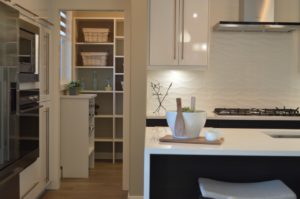The junk drawer. Love it or hate it, most of us have one and most of the time it’s in the kitchen.
That’s rather distressing, isn’t it?
While the garage is the most cluttered room in the house, the kitchen comes in second, tied with the home office.
Surveyed homeowners complained of mail cluttering the kitchen countertops and small electrical appliances hanging around, taking up space.
There are those who describe the kitchen junk drawer as the has-been bin. That roll-out repository where you toss your odds and ends.
And, that’s ok, until the odds and ends and the has-been start cluttering the kitchen counters. Let’s look at some ways to bring order to the kitchen.
Acceptable clutter
Some items are considered acceptable clutter. These include dish towels, cutting boards, dish soap, scrub brushes and those small electrical appliances that we often leave out on the counter.
These appliances, if not used daily, really should be put away, in
our opinion, especially if your home is on the market. Not only does doing so make the kitchen look less cluttered but it helps free up valuable counter space.
Many professional organisers say, however, that if you use something every day, like the toaster, it deserves a spot on the counter or you’ll drive yourself batty by having to drag it out every morning.
If you make toast every morning for breakfast, it’ll take roughly 3 minutes to toast your bread. After that, the toaster will sit unused for the next 23 hours and 57 minutes. You use it far less than you think you do!
Where to put everything
Of course, you’re going to need to pull everything out of every cupboard to get this project done right. Then, you’ll need to figure out the most organised manner of putting everything back.
We love author and baking expert Alice Medrich’s description of how to allocate kitchen space—it’s so very real estate-ish.
She divides kitchen items among three storage areas and calls them:
- Prime real estate: which includes the counters, utensil crocks and cabinets that are within easy reach
- Suburbs: a pantry or closet that is located close to the kitchen
- Outlands: think of these as the rural areas and they include the garage, basement and those shelves or cupboards that you need a stepladder to reach.
She suggests starting with the prime real estate first so you get some instant gratification going. Wherever you decide to start, you’ll be putting things away according to how often they’re used.
Seldom-used items should either be stored in another room or placed in the back of the cupboard. You might also want to install shelves to store some of the more decorative but lightly-used items.
Those appliances you use once a month can go toward the middle of the cupboard and anything you use frequently should go to the front.
Make your storage space work harder
A pantry in the kitchen is a major bonus and most of our home-buying clients agree with us on that. The roomier the better, but even a small pantry can be forced to work hard.
The broad “zones” used in the pantry may be baking items, pasta and rice, breakfast items and snacks. Then, organise each of these zones by placing seldom-used food items toward the back of the zone and those used daily in the front.
Use baskets to hold like items, such as beeswax food wrap, (are you still using plastic wrap?) foil and sandwich bags, in one spot.
For additional pantry organising tips, visit Better Homes & Gardens
Hint: To jump-start the de-cluttering process — or to keep the momentum going — it may be necessary to invite a friend in to play “bad cop” once in a while. It works. Be sure to return the favour.

Do you have a question on the local Real Estate market, or should you spend money on a renovation of your home before you sell, just call Matt Wineera on 0274 951 536 who is always on hand to answer your query.
Work with Matt Wineera who lists and sells in the Tauranga, Mount Maunganui and Papamoa areas.


